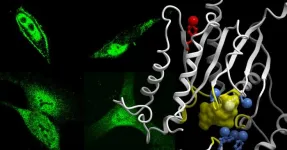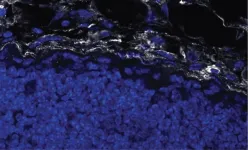(Press-News.org) For the first time, researchers have identified a group of neurons deep in the brain that are associated directly with compulsive eating and food craving. The discovery is reported in an article published in Nature Communications by researchers at the University of California, Los Angeles (UCLA) in the United States and the Federal University of the ABC (UFABC) in São Bernardo do Campo, São Paulo state (Brazil).
The neurons are located in the periaqueductal gray, a region of the midbrain at the top of the brainstem, and are known as vesicular GABA transporter cells, or VGAT cells for short. They use the neurotransmitter GABA (gamma-aminobutyric acid), which plays an important role in the regulation of neuronal activity. They are present in several parts of the brain and spinal cord, contributing to the modulation of mood, sleep, anxiety and response to stress, among other functions.
“However, nothing was known about the link between VGAT cells in the periaqueductal gray and feeding,” said Avishek Adhikari, a professor in UCLA’s Department of Psychology and head of its neuroscience lab, which focuses on how the brain coordinates the constellation of changes relating to aversive emotions such as fear and panic.
The discovery was accidental. “We were interested in anxiety rather than feeding when we began investigating the neurons of the periaqueductal gray,” said Brazilian neuroscientist Fernando Reis, first and corresponding author of the article, and a postdoctoral fellow at UCLA.
FAPESP supported the research via three projects (16/17329-3, 19/17677-0 and 19/17892-8).
The researchers’ initial hypothesis was that activation of VGAT cells should inhibit fear and panic reactions. “When we activated them in mice, that didn’t happen, but the mice began frantically looking for food,” Reis said.
He decided to conduct further experiments, which produced surprising results. Even in completely sated mice that should not have felt hungry, activation of the cells in question triggered vigorous foraging behavior and led them to eat more than usual. The opposite also happened. Mice deliberately left without food in order to make them hungry ate less when their VGAT neurons were inhibited.
During the tests, the scientists noticed that the mice appeared to enjoy the stimulation they received. “They spent longer on the side of the box where they received stimulation to activate their periaqueductal VGAT cells. We believe the compulsive foraging produced positive sensations associated with pleasure and reward,” Reis said.
The mice were also willing to surmount obstacles in order to seek food. “To reach titbits such as walnuts, they climbed a small wire mesh ladder that delivered low-voltage electrical shocks. That couldn’t have been pleasant, but the urge to feed and receive a reward was stronger than the discomfort,” Adhikari said.
Light stimulation
The neural circuit stimulated by the researchers corresponds to 10%-12% of the nerve cells in the periaqueductal gray. They used optogenetics to activate the neuron cluster selectively. “In our case, the problem optogenetics aims to solve is how to manipulate the activity of a subgroup of cells in a specific area of the brain,” said Adhikari, who trained as a postdoc at the Stanford University lab in the United States where the technique was developed.
The researchers used optogenetics to make the neurons sensitive to light so that they could be stimulated or inhibited. They did so by injecting into the mice’s brains a genetically modified virus carrying a light-sensitive protein obtained from green algae. “The selected neuron population infected with the modified virus receives this photosensitive protein together with instructions to produce it,” said Alexandre Kihara, a professor at UFABC and one of five Brazilians in the team of researchers who discovered the link between this subgroup of VGAT cells and food.
Fiber-optic cannulas were implanted in the mice to deliver blue light to the infected cells. “The light stimulus is captured by the photosensitive protein and converted into electrical activity. Cells are made more or less active according to the wavelength of the light emitted,” said Juliane Ikebara, a co-author of the article. She was supported by FAPESP as a PhD candidate at UFABC during the study.
The mice’s behavior changed drastically in response to the blue light. “We saw well-fed, sated animals charge off in hot pursuit of insects to devour,” Adikhari said.
Mapping of the neural networks involved showed that the increase in GABA affected areas deep inside the brain, such as the zona incerta, a thin layer of gray matter below the thalamus. “We observed an increase in neural activity in this area when the mice were approaching food,” he said.
The most important question is whether stimulation of the same brain region triggers compulsive eating in humans. Like mice, humans also possess VGAT periaqueductal gray cells in the brainstem, previous research has shown. Subjecting the region to a mild electrical current triggers symptoms of fear, panic and analgesia in both humans and rodents. The researchers believe a person might feel more rewarded by eating or crave more food even on a full stomach if this circuit is overactive, and vice-versa.
“Our findings can’t be directly tested in humans right now, but future studies may show whether activation of VGAT periaqueductal gray cells in monkeys triggers a search for food, suggesting that something similar happens in humans,” Adhikari said.
The group has embarked on new studies to investigate whether neuron stimulation induces a craving for protein- or sugar-rich food, among other aspects. “The mice weren’t interested in vegetables. They preferred sausages, sugar, cheese and chocolate,” he said.
For the researchers, the discovery that stimulation or inhibition of this specific brain region causes similar behavior to that seen in binge eating or anorexia could lead to the exploration of novel approaches to eating disorders.
About São Paulo Research Foundation (FAPESP)
The São Paulo Research Foundation (FAPESP) is a public institution with the mission of supporting scientific research in all fields of knowledge by awarding scholarships, fellowships and grants to investigators linked with higher education and research institutions in the State of São Paulo, Brazil. FAPESP is aware that the very best research can only be done by working with the best researchers internationally. Therefore, it has established partnerships with funding agencies, higher education, private companies, and research organizations in other countries known for the quality of their research and has been encouraging scientists funded by its grants to further develop their international collaboration. You can learn more about FAPESP at www.fapesp.br/en and visit FAPESP news agency at www.agencia.fapesp.br/en to keep updated with the latest scientific breakthroughs FAPESP helps achieve through its many programs, awards and research centers. You may also subscribe to FAPESP news agency at http://agencia.fapesp.br/subscribe.
END
Researchers discover neural circuit involved in compulsive eating even without hunger
In a study involving mice, scientists used a technique that combines light stimulation and bioengineering to activate a cluster of nerve cells deep inside the brain. The discovery could pave the way to future treatment of eating disorders.
2024-06-04
ELSE PRESS RELEASES FROM THIS DATE:
Accelerating the R&D of wearable tech: Combining collaborative robotics, AI
2024-06-04
College Park, Md. — Engineers at the University of Maryland (UMD) have developed a model that combines machine learning and collaborative robotics to overcome challenges in the design of materials used in wearable green tech.
Led by Po-Yen Chen, assistant professor in UMD's Department of Chemical and Biomolecular Engineering, the accelerated method to create aerogel materials used in wearable heating applications – published June 1 in the journal Nature Communications – could automate design processes for new materials.
Similar to water-based ...
Chasing down a cellular ‘short circuit’
2024-06-04
A group of researchers at University of California San Diego has identified the cause of a “short-circuit” in cellular pathways, a discovery that sheds new light on the genesis of a number of human diseases.
The recent study, published in the journal Science Signaling, explores the biochemical mechanism that can interrupt the cellular communication chain — a disruptive interaction that Pradipta Ghosh, M.D., likens to a game-ending “buzzer.” Ghosh, a professor in the Departments of Medicine and Cellular and Molecular Medicine ...
When mothers and children talk about problems, environment matters
2024-06-04
URBANA, Ill. – Talking to their parents about daily stressors can help adolescents deal with their problems. This is particularly important during the transition to middle school, when youth often are faced with new peer and academic challenges. But does it matter where these conversations take place? That’s the topic of a new study from the University of Illinois Urbana-Champaign.
“We were interested in the environmental settings for mother-youth conversations. Where do they typically happen, and what are the preferred locations? We wanted to get the perspectives of both the youth and their ...
How tumor stiffness alters immune cell behavior to escape destruction
2024-06-04
Immunotherapy is based on harnessing a person’s own immune system to attack cancer cells. However, patients with certain tumors do not respond to these therapies and it remains unclear why.
“The full impact of anti-cancer immunotherapy has not been realized, especially for some solid tumors,” says Kevin Tharp, Ph.D., assistant professor in the Cancer Metabolism and Microenvironment Program at Sanford Burnham Prebys.
Researchers presume that part of the reason why these therapies fail is due to tumor-associated fibrosis, the creation of a thick layer of fibrous collagen (like scar tissue) that acts as a barrier ...
Convergence and collaboration to achieve circularity
2024-06-04
The linear consumption model of raw material extraction, production, use, and disposal dominates the global economy, but it’s led to serious unintended global consequences: from resource use to pollution including negative impacts on environmental and human health that disproportionately affect the Global South.
In contrast, circular economy – a model where products and materials are by design kept in continual use – aims to decouple economic growth from resource consumption.
While approaches ...
Wayne State University partners with Great Lakes Water Authority to help train water pipeline managers of the future
2024-06-04
DETROIT — The Great Lakes Water Authority (GLWA) has partnered with Wayne State University to develop its Workforce Development and Pipe Management Program, which will help recruit, teach and graduate the next generation of water pipeline managers. The two-year program will begin July 1, 2024, and will be supported by a contract totaling more than $480,000.
The GLWA says that water utilities are experiencing significant employee recruitment, training and retention challenges. An additional concern is the availability of specialized technical training that addresses recent technological advances in the water sector. In response to these challenges, the Workforce Development and ...
NRG Oncology abstract considered “best of ASCO” for 2024 shows difference in outcomes for node-negative versus node-positive pancreatic cancer patients when adding chemoradiation to systemic therapy
2024-06-04
NRG Oncology recently reported the results from the radiotherapy randomization, which was the second step of their NRG-RTOG 0848 clinical study comparing adjuvant chemotherapy with or without chemoradiation for patients with resected periampullary pancreatic adenocarcinoma. The trial data did not show that the addition of radiation and chemotherapy to adjuvant systemic therapy improved overall survival (OS) for all patients on the study, however, OS was improved among node-negative patients. OS was essentially the same between treatment arms for node positive patients. The trial data also showed that disease-free survival (DFS) was improved with ...
Emma Guttman-Yassky, MD, Ph.D., receives high honor at European Academy of Allergy and Clinical Immunology
2024-06-04
Emma Guttman-Yassky, MD, PhD, Receives High Honor at European Academy of Allergy and Clinical Immunology
The Paul Ehrlich Award for Experimental Research recognizes scientists who have revolutionized the understanding of allergic diseases and immunological mechanisms.
New York, NY (June 4, 2024) – The 2024 European Academy of Allergy and Clinical Immunology (EAACI) Annual Congress selected Emma Guttman-Yassky, MD, PhD, Waldman Chair of the Kimberly and Eric J. Waldman Department of Dermatology, and Professor of Dermatology and Immunology, Icahn School of Medicine at Mount Sinai, as the recipient of the ...
An anti-inflammatory curbs spread of fungi causing serious blood infections
2024-06-04
A team of UC Davis Health researchers discovered that a common anti-inflammatory drug, mesalamine, can replace the work of good bacteria in fighting the nasty fungus Candida albicans in the gut.
C. albicans, or candida, is known to cause yeast infections. In some cases, it develops into invasive candidiasis, a potentially fatal infection occurring mostly in patients with compromised immunity.
The researchers found that this fungus can’t grow without an oxygen supply. Their study in mice showed that the drug can ...
Intracerebral hemorrhage stroke outcomes improve with early minimally invasive surgery evaluated in clinical trial
2024-06-04
INDIANAPOLIS – Patients with an intracerebral hemorrhage have better medical outcomes when surgeons perform an early minimally invasive removal of a hematoma compared to those receiving the standard of care, according to a study published in the New England Journal of Medicine.
Indiana University School of Medicine faculty clinicians Mitesh Shah, MD, Bradley Bohnstedt, MD, Regg Singh, MD and Jason Allen, MD, PhD are co-authors ...
LAST 30 PRESS RELEASES:
Cannabis legalization is driving increases in marijuana use among U.S. adults with historically lower consumption rates
Multifunctional dipoles enabling enhanced ionic and electronic transport for high‑energy batteries
Triboelectric nanogenerators for future space missions
Advancing energy development with MBene: Chemical mechanism, AI, and applications in energy storage and harvesting
Heteroatom‑coordinated Fe–N4 catalysts for enhanced oxygen reduction in alkaline seawater zinc‑air batteries
Meta-device for precision lateral displacement sensing
Plasma-guided mitotane for the treatment of adrenocortical carcinoma: adjuvant care to advanced disease
Theoretical study of laser-enhanced nuclear fusion reactions
Social environment impacts sleep quality
Optimized kinetic pathways of active hydrogen generation at Cu2O/Cu heterojunction interfaces to enhance nitrate electroreduction to ammonia
New design playbook could unlock next generation high energy lithium ion batteries
Drones reveal how feral horse units keep boundaries
New AI tool removes bottleneck in animal movement analysis
Bubble netting knowledge spread by immigrant humpback whales
Discovery of bats remarkable navigation strategy revealed in new study
Urban tributaries identified as major sources of plastic chemical pollution in the Yangtze River
UK glaucoma cases higher than expected and projected to reach 1.6 million+ by 2060
Type 2 diabetes prevention could more than halve carbon footprint linked to disease complications
Over 1 million estimated to have glaucoma in UK
Early treatment can delay rheumatoid arthritis for years
National childhood type 1 diabetes screening is effective and could prevent thousands of emergency diagnoses, UK study shows
Mix of different types of physical activity may be best for longer life
Continuous care from community-based midwives reduces risk of preterm birth by 45%
Otago experts propose fiber as first new essential nutrient in 50 years
Auburn Physics PhD student earns prestigious DOE Fellowship
AI tool helps you learn how autistic communication works
To show LGBTQ+ support, look beyond Pride Month
Using artificial intelligence to understand how emotions are formed
Exposure to wildfire smoke late in pregnancy may raise autism risk in children
Breaking barriers in lymphatic imaging: Rice’s SynthX Center leads up to $18 million effort for ‘unprecedented resolution and safety’
[Press-News.org] Researchers discover neural circuit involved in compulsive eating even without hungerIn a study involving mice, scientists used a technique that combines light stimulation and bioengineering to activate a cluster of nerve cells deep inside the brain. The discovery could pave the way to future treatment of eating disorders.



